I have been to Penang many times ever since I took a rumbling bus from Singapore with my buddy TTP, when we were teenagers. I always remembered Penang as a foodie's paradise because of it's wide variety of delicious multicultural street food. So, I was not surprised at all that Lonely Planet picked Penang as top spot in the world for foodies in 2014.
Singapore Blog Award 2014 Winner's Interview with OMY/ My Paper

An excerpt of my interview with OMY was translated into Mandarin and published in My Paper and U Weekly 优1周 UW on 10 Nov 2014.
Here is the full interview in the original English.
1. What do you really blog about?

I blog anything about food and travel that moves me to write and share. Though anchored on the core of food and travel, I am not going to set boundaries for my own space.
Having said that, what moves me are the unfancied and untold.
I love blogging for the underdogs. The unsung food heroes. The untold food and people stories. Hence, Johor hawkers, which was where I started in the beginning. I have been looking for more unheralded food. For example, I am now looking at new immigrant food in Singapore.
2. What do you think is special / unique about your blog, that's different from most other food blogs?

My blog draws widely differing reactions from readers.
A judge in the OMY Blog Awards panel commented that my blog is "full of life and filled with the human touch".
Perhaps, because most of my content is so mundane and familiar, I have to look deeper to find interesting angles to present to the reader.
Find beauty in the ordinary.
3. How much ($) do you spend into running your blog on average each month?

About SGD1,500 a month. Mostly on food and transport. I am using Google's Blogger which is an essentially free platform and hosting service like YouTube which also belongs to Google.
4. Being a food blogger, how do you avoid "eating too much" and putting on weight?
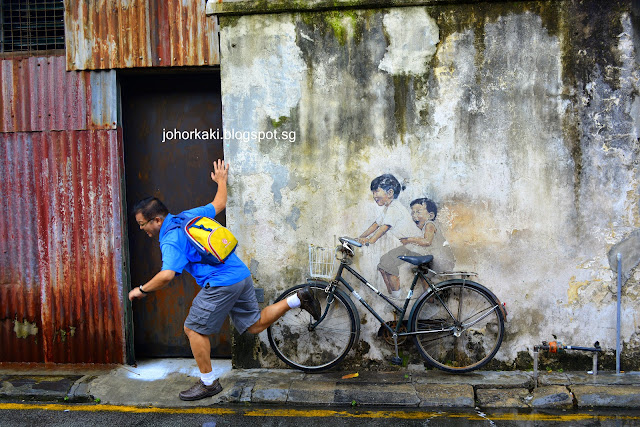
Yeah, I have a extra big challenge. I actually try to eat all the food that I am served instead of just tasting small sampling bites. It's an attitude my mum instilled in us when we were children. It got stuck.
When not food tasting, I try to have simple meals like more oats and fruits. I brisk walk at least an hour a day except when the haze prevents me. Actually, my way of blogging involves a lot of walking. I often park my car and walk around the shop houses, markets and coffee shops to sniff out good food.
5. What are the best and worst experiences you've had in your blogging journey?
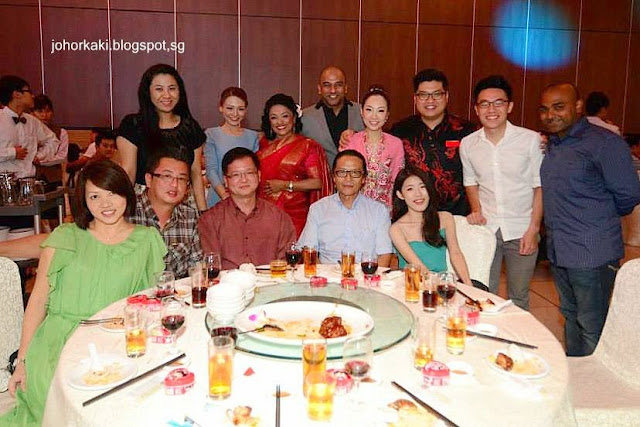
At the wedding of Bryan and Sue May
The best experiences is when I am able to make a positive connection with people, and between people.
Hawkers invite me to their homes and introduce me to their families. Sometimes strangers at other tables paid for my meal before I went to settle the bill. Strangers came to say hello. I attend readers' weddings and other private celebrations. Johoreans overseas write to me to tell me my blog keeps them connected with home. Johoreans write to me to tell me that they are discovering their own hometowns through my blog.
Worst experiences are when I got chased away by hawkers, which still happens once in a while.
Social media is a very new phenomenon, so some misunderstandings are inevitable. I myself am quite confused by social media, say just three years ago.
Some hawkers are wary of bloggers because of bad experiences, so their defensive reaction is understandable.
6. How do you deal with the bad experiences, if any?

Too blessed to be stressed
I just remind myself of the objective and social purpose of what I am doing and that always gets me recharged for the next blogging trip. In any case, by far most of my encounters are very heartwarming and positive, so I know that the occasional humps along the journey are just exceptions.
7. What do you wish to see more or less of the blogging community, perhaps especially for the very competitive food scene?
I hope more people realise the possibilities and opportunities blogging and social media create for community service.
For example, I wish more bloggers join me to explore the new cuisine that new immigrants are bringing to our food culture. Yes, create more awareness of the new comfort foods that are entering Singapore's food culture. In this way, food can serve as a bonding tool as it had done before when our forefathers too came to this island from other shores.
Though Singapore probably has the highest density of food bloggers in the world, the voices are not as varied and diverse. I hope there are more trend setters rather than trend followers.
8. Say a few words about winning in Singapore Blog Awards 2014!

Firstly, my gratitude to the hawkers whose stories won the readers' and judges' hearts - I am just a scribe. My heartfelt thanks to my readers in Singapore and overseas for voting for Johor Kaki. I would like to congratulate and thank SBA for playing a crucial role of setting the quality benchmark for blogging in Singapore every year.
Tony
3rd Road 888 Hokkien Mee Lebuh Presgrave in Penang 三條路888福建面
Penang is famous for many good food like Penang char kway teow, Penang asam laksa, Penang curry mee, Penang nasi kandar but many Penangites told me that it's Hokkien mee they turn to for comfort food. You can find Penang Hokkien mee everywhere in Penang at anytime.
Modern day Hokkien mee is a gentrified version of a dish with very humble roots. (Penang Hokkien mee is known as prawn mee in Johor and Singapore.)

I am told by locals that Hokkien mee was created out of bad times. The dish appeared during the Japanese Occupation of Malaya from 1942 to 1945.
During those dark years, too poor to buy the usual ingredients for their food, locals turn to whatever was available at hand.
The local fishermen made stock using discarded prawn heads and shells because the Japanese took all the prawn meat. The dish uses only tiny wild caught sua lor prawns as the bigger meatier prawns always landed on Japanese tables. There were small, thin slices of pork as the fishermen exchanged fish for pork with their equally impoverished pig farmer compatriots. The fishermen threw in a few stems and leaves of crunchy kang kong in the dish as these weeds were abundant in long kangs (drains and canals). The broth and ingredients were eaten with yellow wheat noodles or rice noodles. Fresh chili sauce was used to spice up the dish. Chili was abundant because it was not part of Japanese diet.
Modern day Hokkien mee is a gentrified version of a dish with very humble roots. (Penang Hokkien mee is known as prawn mee in Johor and Singapore.)

I am told by locals that Hokkien mee was created out of bad times. The dish appeared during the Japanese Occupation of Malaya from 1942 to 1945.
During those dark years, too poor to buy the usual ingredients for their food, locals turn to whatever was available at hand.
The local fishermen made stock using discarded prawn heads and shells because the Japanese took all the prawn meat. The dish uses only tiny wild caught sua lor prawns as the bigger meatier prawns always landed on Japanese tables. There were small, thin slices of pork as the fishermen exchanged fish for pork with their equally impoverished pig farmer compatriots. The fishermen threw in a few stems and leaves of crunchy kang kong in the dish as these weeds were abundant in long kangs (drains and canals). The broth and ingredients were eaten with yellow wheat noodles or rice noodles. Fresh chili sauce was used to spice up the dish. Chili was abundant because it was not part of Japanese diet.
Made out of mostly discards, an iconic, wonderfully tasty dish was created out of desperation.
However, authentic aka 1940s Hokkien mee is hard to find even in Penang today.

Irene brought me to this very popular Lebuh Presgrave 888 Hokkien Mee 三條路 888 福建面 near her own old office.

三條路 888 福建面 stall is near the iconic Komtar tower and along the same road as Kwong Wah Yit Poh newspaper.

Step behind the humble push cart stall, and there are plenty of seats.
The Hokkien mee here at 三條路 was indeed superb, though it is far removed from its humble 1940s predecessor. 三條路 serves lots of extras, luxuries which appeal to today's customers.

The tiny sua lor were there. Lots of it.

The pork slices were there. In good, generous sized slices.

We can add sio bak or roast belly pork to this Hokkien mee.

How about braised pork trotter or intestines? Pork ribs?

Here you can even get ping pong size fish balls to go with your Hokkien mee.
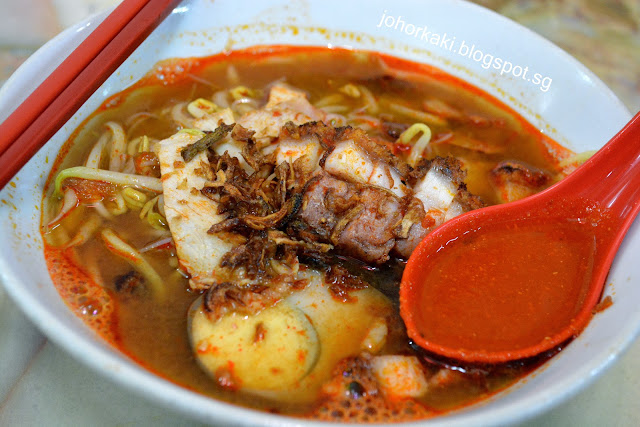
Our bowl of Penang Hokkien mee. We indulged in a little added on sio bak.

The soul of Hokkien mee is in it's prawny broth. At 三條路 888, the sweet and savoury broth rocks.

Second to the prawny broth, to me, the chili sauce is what sets Penang Hokkien mee apart from the versions in Johor and Singapore. The full bodied chili sauce has a sharp sting and is the ingredient that balances the savoury crustacean flavour in the broth.

The sio bak was nice, but it was just nice to have. Personally, just the ordinary little prawns and skinny pork slices do fine :D

The boss was extremely busy, so we did not get to speak with her. Just a smile, quick hello and thank you, as we were leaving.
Acknowledgement: Original Century Food Pte Ltd, maker of MyOri Penang White Curry Noodles supported my visit to Penang and my mission to "Put Every Good Hawker on the World Wide Web".
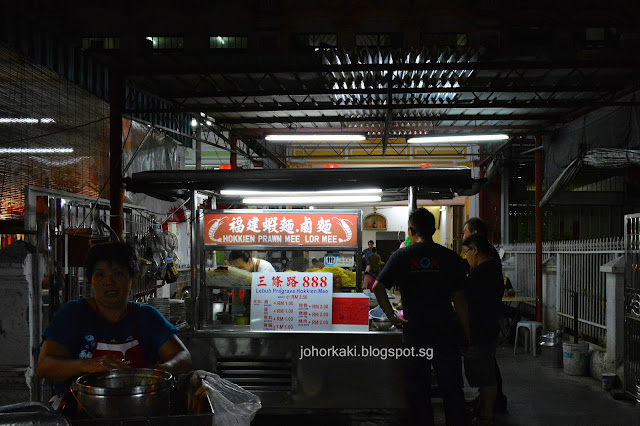
Restaurant name: Lebuh Presgrave 888 Hokkien Mee 三條路888福建面
Address: Off Lebuh McNair, corner lot 67-A Lebuh Presgrave, Georgetown, Penang
GPS: 5.411001,100.330694
Hours: 4:30pm to 12:00 midnight (Closed on Thurs)
Non Halal
Date visited: 26 Oct 2014
However, authentic aka 1940s Hokkien mee is hard to find even in Penang today.

Irene brought me to this very popular Lebuh Presgrave 888 Hokkien Mee 三條路 888 福建面 near her own old office.

三條路 888 福建面 stall is near the iconic Komtar tower and along the same road as Kwong Wah Yit Poh newspaper.

Step behind the humble push cart stall, and there are plenty of seats.
The Hokkien mee here at 三條路 was indeed superb, though it is far removed from its humble 1940s predecessor. 三條路 serves lots of extras, luxuries which appeal to today's customers.

The tiny sua lor were there. Lots of it.

The pork slices were there. In good, generous sized slices.

We can add sio bak or roast belly pork to this Hokkien mee.

How about braised pork trotter or intestines? Pork ribs?

Here you can even get ping pong size fish balls to go with your Hokkien mee.

Our bowl of Penang Hokkien mee. We indulged in a little added on sio bak.

The soul of Hokkien mee is in it's prawny broth. At 三條路 888, the sweet and savoury broth rocks.

Second to the prawny broth, to me, the chili sauce is what sets Penang Hokkien mee apart from the versions in Johor and Singapore. The full bodied chili sauce has a sharp sting and is the ingredient that balances the savoury crustacean flavour in the broth.

The sio bak was nice, but it was just nice to have. Personally, just the ordinary little prawns and skinny pork slices do fine :D

The boss was extremely busy, so we did not get to speak with her. Just a smile, quick hello and thank you, as we were leaving.
Acknowledgement: Original Century Food Pte Ltd, maker of MyOri Penang White Curry Noodles supported my visit to Penang and my mission to "Put Every Good Hawker on the World Wide Web".

Restaurant name: Lebuh Presgrave 888 Hokkien Mee 三條路888福建面
Address: Off Lebuh McNair, corner lot 67-A Lebuh Presgrave, Georgetown, Penang
GPS: 5.411001,100.330694
Hours: 4:30pm to 12:00 midnight (Closed on Thurs)
Non Halal
Date visited: 26 Oct 2014
Return to Johor Kaki homepage.
What is Penang White Curry Noodles? Air Itam Sisters Curry Laksa Mee
By now most of us have eaten the instant version, if not at least heard of, Penang White Curry Noodles, thanks to at least 25 brands of the instant noodle craze.
So, on my first trip to Penang (after 10 years), I told myself that I must taste some real Penang White Curry Noodles.
This morning my friends Irene and CJ took me all the way from Georgetown to Air Itam to track down this well loved Penang White Curry Noodle stall.
"You have to squat or sit on small stools to eat", Irene warned me. "No problem!" I told Irene. In fact, I think that is very fun and charming 😄
This no signboard stall is at the busy market near to the famous Kek Lok Si temple in Air Itam, Penang.

You cannot find a more humble stall.
This is a no signboard stall under a big tree on a side lane off the main road, Jalan Air Itam. The stall is along the same lane leading to Air Itam Chinese Methodist Church.
The stall is set on the floor. A hanging green canvas curtain barely shielding the stall from the blazing morning sun. An assortment of small stools of different heights were strewn across the front of the stall.
(There is more comfortable seating across the lane at the small kopi stall and dim sum stall. Just need to buy some items from these stalls and they will allow customers to use their tables and chairs.)


This very humble no sign board stall is run by two elderly sisters. (So, this stall is also known as the "Air Itam sisters curry mee".)
Beautiful ladies Lai 来 (left) and Heang 香 in their eighties, seated on small stools were hard at work, and very cheerful and sprightly. They were obviously enjoying themselves.

No one is certain who invented Penang White Curry Noodles but sisters Heang 香 and Lai 来 who have been selling this dish in Air Hitam in Penang for over 60 years, are definitely among the pioneers 😄
"When we started, a bowl of curry mee cost 10 sens", Hiang 香 told me proudly. (It's RM4 a bowl today in 2014.)

This is the large pot of broth with tau pok (fried tofu), kept simmering over a charcoal stove.
Penang White Curry Noodles keep the spice and coconut broth separate from the chili sauce.

The large pot of fiery pulpy sambal chili.

Here is the not instant Penang White Curry Noodles.

The mildly savoury broth had a light body and little coconut milk. It was also only slightly spicy.
The difference that made all the difference was the sambal chili. When added to the broth, it gave the stock an addictive spicy kick. Customers can add as much of the sambal chili as they can handle - depending on how much hot punishment they can take on their tongue and lips.

The yellow noodles and bee hoon were generic. But, there were several pieces of these pork blood curd (which will excite especially many visitors from Singapore as this is not available on the island).

There were a few small pieces of dried cuttlefish (giu her). Nice chewy mouth feel but the giu her flavour was quite slight.

The sisters also serve this fried mee hoon with giu her but I didn't try it.

This may not be the tastiest curry mee in Penang (I am still looking), but it is probably the most famous and well loved.
When you are in Penang, Air Itam has many interesting sights to visit, including this old school Penang White Curry Noodles. You will not just enjoy a delicious bowl of curry noodles but also witness living history in Penang. This legendary stall alone is worth a trip to Air Itam.
Restaurant name: Two Sisters Penang White Curry Mee (No Signboard)
Address: off Air Itam Market, Jalan Air Hitam, Pekan Ayer Itam, Penang
Map: http://goo.gl/maps/oueQr
GPS: 5.400435,100.278337
Hours: 7:30am to 1:00pm
Non Halal
Date visited: 25 Oct 2014
Return to Johor Kaki homepage.
So, on my first trip to Penang (after 10 years), I told myself that I must taste some real Penang White Curry Noodles.
This morning my friends Irene and CJ took me all the way from Georgetown to Air Itam to track down this well loved Penang White Curry Noodle stall.
"You have to squat or sit on small stools to eat", Irene warned me. "No problem!" I told Irene. In fact, I think that is very fun and charming 😄
This no signboard stall is at the busy market near to the famous Kek Lok Si temple in Air Itam, Penang.

You cannot find a more humble stall.
This is a no signboard stall under a big tree on a side lane off the main road, Jalan Air Itam. The stall is along the same lane leading to Air Itam Chinese Methodist Church.
The stall is set on the floor. A hanging green canvas curtain barely shielding the stall from the blazing morning sun. An assortment of small stools of different heights were strewn across the front of the stall.
(There is more comfortable seating across the lane at the small kopi stall and dim sum stall. Just need to buy some items from these stalls and they will allow customers to use their tables and chairs.)


This very humble no sign board stall is run by two elderly sisters. (So, this stall is also known as the "Air Itam sisters curry mee".)
Beautiful ladies Lai 来 (left) and Heang 香 in their eighties, seated on small stools were hard at work, and very cheerful and sprightly. They were obviously enjoying themselves.

No one is certain who invented Penang White Curry Noodles but sisters Heang 香 and Lai 来 who have been selling this dish in Air Hitam in Penang for over 60 years, are definitely among the pioneers 😄
"When we started, a bowl of curry mee cost 10 sens", Hiang 香 told me proudly. (It's RM4 a bowl today in 2014.)

This is the large pot of broth with tau pok (fried tofu), kept simmering over a charcoal stove.
Penang White Curry Noodles keep the spice and coconut broth separate from the chili sauce.

The large pot of fiery pulpy sambal chili.

Here is the not instant Penang White Curry Noodles.

The mildly savoury broth had a light body and little coconut milk. It was also only slightly spicy.
The difference that made all the difference was the sambal chili. When added to the broth, it gave the stock an addictive spicy kick. Customers can add as much of the sambal chili as they can handle - depending on how much hot punishment they can take on their tongue and lips.

The yellow noodles and bee hoon were generic. But, there were several pieces of these pork blood curd (which will excite especially many visitors from Singapore as this is not available on the island).

There were a few small pieces of dried cuttlefish (giu her). Nice chewy mouth feel but the giu her flavour was quite slight.

The sisters also serve this fried mee hoon with giu her but I didn't try it.

This may not be the tastiest curry mee in Penang (I am still looking), but it is probably the most famous and well loved.
When you are in Penang, Air Itam has many interesting sights to visit, including this old school Penang White Curry Noodles. You will not just enjoy a delicious bowl of curry noodles but also witness living history in Penang. This legendary stall alone is worth a trip to Air Itam.
Restaurant name: Two Sisters Penang White Curry Mee (No Signboard)
Address: off Air Itam Market, Jalan Air Hitam, Pekan Ayer Itam, Penang
Map: http://goo.gl/maps/oueQr
GPS: 5.400435,100.278337
Hours: 7:30am to 1:00pm
Non Halal
Date visited: 25 Oct 2014
Return to Johor Kaki homepage.
Ru Ji Kitchen Handmade Fish Ball Noodle in Holland Drive Hawker Centre Singapore 如记小厨
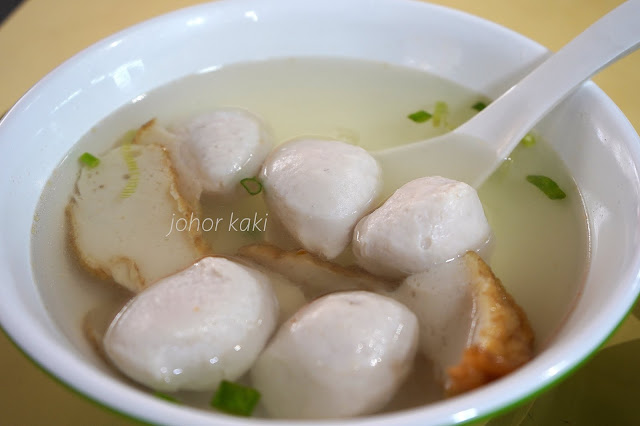
After my medical appointment at NUH this morning, I went over to Ghim Moh hawker centre for Guan Kee char kway teow. Again, the stall was closed - it has always been like this during the last few years. The last time I tasted Guan Kee CKT was some 20 years ago.
Anyway, I popped over to nearby Holland Drive hawker centre for Ru Ji Kitchen's fish ball noodles. It is always open, always honours its published hours. Ru Ji saved the day again for me as their fish ball noodle is always consistently good.
Crocodile Soup Recipe - Ultimate Hawker Fest 2014 Singapore - Return of the Crocodile King 鱷魚大王重出江湖
Once upon a time, long before Johor Kaki was born, there was a Crocodile Kingdom at Old Airport Road food centre in Singapore.
Last year, the Crocodile King went exploring, getting ready to return to his beloved kingdom with the best crocodile dishes for his dear people.
Then, he heard a call for help.
Singapore Touch Community is holding their annual charity food fair, the Ultimate Hawker Fest 2014, to raise funds to help 35,000 needy people under their care.
The Crocodile King has a soft heart, especially for needy people.

Without a second thought, the Crocodile King agreed to serve his Ultimate Herbal Crocodile Soup at the Ultimate Hawker Fest.
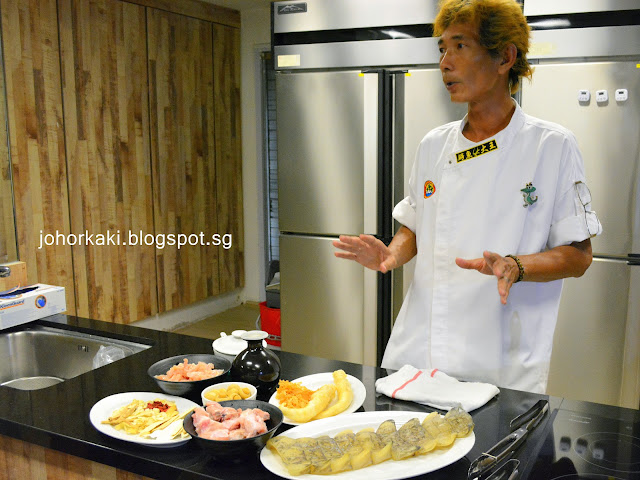
The Crocodile King Tony Tee was even kind enough to conduct a demonstration to show how he makes his Ultimate Herbal Crocodile Soup (venue at the courtesy of The Eureka Cooking Lab in Singapore).

The ingredients (clockwise from top left), dried snow fungus, Chinese wine (五加皮 and 紹興 blend), dried fish maw, herbs (pre-packed), and button mushrooms.

A closer look at the herbs. If the herbs look mysterious to you, relax. You can buy them pre-packed at supermarkets.

Clockwise, sliced crocodile tail meat marinated with sesame oil, crocodile loin bones and crocodile tail fin.

Closer look at the waggley tail.

The herbs, crocodile bones and tail fin were slowed cooked in a pot of water for six hours to make the broth.

Remove the floppy tail fin from the simmering pot and let it cool.

The croc tail fin which is 100% collagen gels on cooling, bringing the spring back to the tail fin softened by long boiling.

Tony snipped the croc tail fin into bite size pieces just before final cooking for serving.
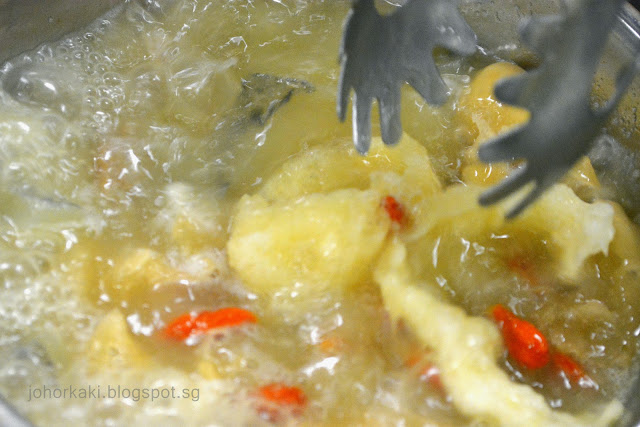
Fast boil the croc tail fin, croc meat slices, dried fish maw pieces, fungus mushroom and canned button mushrooms in the crocodile broth just before serving.

Voila!!
The Ultimate Herbal Crocodile Soup.
No kidding.

I indulged in a squirt of wu jia pi and shao xing 五加皮 and 紹興 blend :D

This is the most delicious herbal broth that I have had for a long time.
The broth had a smooth, round body, well balanced sweet and savoury flavours, very mild likable herbal taste, and a touch of old Chinese wine taste and aroma. There was hardly any grease at all.
Superb.
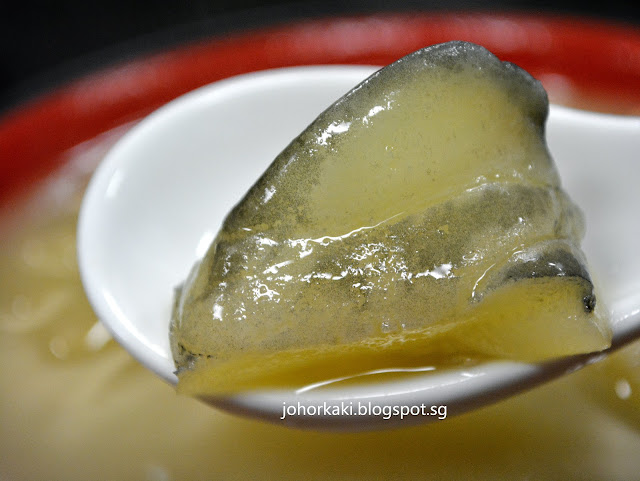
The gummy, jelly like tail fin. 100% natural collagen :D

The crocodile meat tasted like good fresh fish and had the texture of tender lean pork.
Crocodile King Tony Tee sharing with us the benefits of herbal crocodile soup. Check out the video for all the benefits of the tonic :D
I am always sceptical about people claiming themselves king of this, or princess of that. But, after tasting the Crocodile King's Ultimate Herbal Crocodile Soup today, I have to acknowledge that Tony is truly Your Royal Highness of the Crocodile Kingdom :D
I am already missing Tony's Ultimate Herbal Crocodile Soup.
I am looking forward to the Crocodile King's return, when the time is ripe.
Meanwhile, we have two options.
Option one.
Do it yourself. DIY.

Tony said we can buy this pre-packed herbs and also crocodile meat and bones at supermakets. Just follow the instructions on the packet of herbs, and you will have good (not ultimate) herbal crocodile soup.
The second option, get the Ultimate version with the added bonus of meeting the Crocodile King 鱷魚大王 Tony Tee in person by visiting the charity Ultimate Hawker Fest 2014.
Date: 22 Nov 2014
Venue: SUNTEC Halls 401-402
Time: 11:00am to 5:00pm
Get your Singapore Ultimate Hawker Fest 2014 coupons here.
Either way, if you miss the good or Ultimate Herbal Crocodile Soup, you will regret it.
Return to Johor Kaki homepage.
Last year, the Crocodile King went exploring, getting ready to return to his beloved kingdom with the best crocodile dishes for his dear people.
Then, he heard a call for help.
Singapore Touch Community is holding their annual charity food fair, the Ultimate Hawker Fest 2014, to raise funds to help 35,000 needy people under their care.
The Crocodile King has a soft heart, especially for needy people.

Without a second thought, the Crocodile King agreed to serve his Ultimate Herbal Crocodile Soup at the Ultimate Hawker Fest.

The Crocodile King Tony Tee was even kind enough to conduct a demonstration to show how he makes his Ultimate Herbal Crocodile Soup (venue at the courtesy of The Eureka Cooking Lab in Singapore).

The ingredients (clockwise from top left), dried snow fungus, Chinese wine (五加皮 and 紹興 blend), dried fish maw, herbs (pre-packed), and button mushrooms.

A closer look at the herbs. If the herbs look mysterious to you, relax. You can buy them pre-packed at supermarkets.

Clockwise, sliced crocodile tail meat marinated with sesame oil, crocodile loin bones and crocodile tail fin.

Closer look at the waggley tail.

The herbs, crocodile bones and tail fin were slowed cooked in a pot of water for six hours to make the broth.

Remove the floppy tail fin from the simmering pot and let it cool.

The croc tail fin which is 100% collagen gels on cooling, bringing the spring back to the tail fin softened by long boiling.

Tony snipped the croc tail fin into bite size pieces just before final cooking for serving.

Fast boil the croc tail fin, croc meat slices, dried fish maw pieces, fungus mushroom and canned button mushrooms in the crocodile broth just before serving.

Voila!!
The Ultimate Herbal Crocodile Soup.
No kidding.

I indulged in a squirt of wu jia pi and shao xing 五加皮 and 紹興 blend :D

This is the most delicious herbal broth that I have had for a long time.
The broth had a smooth, round body, well balanced sweet and savoury flavours, very mild likable herbal taste, and a touch of old Chinese wine taste and aroma. There was hardly any grease at all.
Superb.

The gummy, jelly like tail fin. 100% natural collagen :D

The crocodile meat tasted like good fresh fish and had the texture of tender lean pork.
Crocodile King Tony Tee sharing with us the benefits of herbal crocodile soup. Check out the video for all the benefits of the tonic :D
I am always sceptical about people claiming themselves king of this, or princess of that. But, after tasting the Crocodile King's Ultimate Herbal Crocodile Soup today, I have to acknowledge that Tony is truly Your Royal Highness of the Crocodile Kingdom :D
I am already missing Tony's Ultimate Herbal Crocodile Soup.
I am looking forward to the Crocodile King's return, when the time is ripe.
Meanwhile, we have two options.
Option one.
Do it yourself. DIY.

Tony said we can buy this pre-packed herbs and also crocodile meat and bones at supermakets. Just follow the instructions on the packet of herbs, and you will have good (not ultimate) herbal crocodile soup.
The second option, get the Ultimate version with the added bonus of meeting the Crocodile King 鱷魚大王 Tony Tee in person by visiting the charity Ultimate Hawker Fest 2014.
Date: 22 Nov 2014
Venue: SUNTEC Halls 401-402
Time: 11:00am to 5:00pm
Get your Singapore Ultimate Hawker Fest 2014 coupons here.
Return to Johor Kaki homepage.
Labels:
Crocodile,
Recipes,
Singapore,
Ultimate Hawker Fest
Subscribe to:
Posts (Atom)

